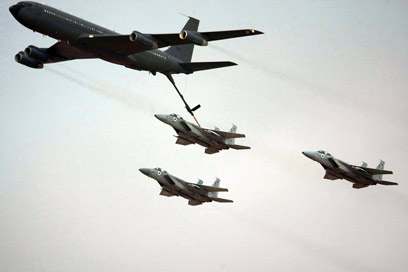
An Israeli attack on Iran's nuclear sites would be a highly complex operation and would require at least 100 planes, the New York Times quoted American defense officials and military analysts close to the Pentagon as saying.
According to the officials, whose assessment was published by the newspaper on Monday, Israeli jets would have to refuel in the air en route, fight off Iran’s air defenses and attack multiple underground sites simultaneously.
Related articles:
- Op-ed: Raising the stakes on Iran
- FM: Israel knows how to handle Iranian threat
- NYT: Israeli attack on Iran would aggravate situation
- NYT: Israeli attack on Iran would aggravate situation
The officials told NYT that a strike on Iran would be far different from Israel’s “surgical” strikes on a nuclear reactor in Syria in 2007 and Iraq’s Osirak reactor in 1981.
"All the pundits who talk about ‘Oh, yeah, bomb Iran,’ it ain’t going to be that easy,” said Lt. Gen. David A. Deptula, who retired last year as the US Air Force’s top intelligence official and who planned the American air campaigns in 2001 in Afghanistan and in the 1991 Gulf War.
Andrew R. Hoehn, a former Pentagon official, told NYT "I don’t think you’ll find anyone who’ll say, ‘Here’s how it’s going to be done — handful of planes, over an evening, in and out.’”
According to the report, Michael V. Hayden, who was the director of the Central Intelligence Agency from 2006 to 2009, said last month that airstrikes capable of seriously setting back Iran’s nuclear program were “beyond the capacity” of Israel, in part because of the distance that attack aircraft would have to travel and the scale of the task.
Military analysts told NYT the first problem Israel faces is how to get to Iran. They said there are three potential routes: to the north over Turkey, to the south over Saudi Arabia or taking a central route across Jordan and Iraq.
The analysts said the route over Iraq would be the most direct and likely, because Iraq effectively has no air defenses and the US, following its December pullout, no longer has the obligation to defend Iraqi skies.

Airborne refueling (Photo: AFP)
Assuming that Jordan tolerates the Israeli overflight, the NYT report said, the next problem is distance.
"Israel has American-built F-15I and F-16I fighter jets that can carry bombs to the targets, but their range — depending on altitude, speed and payload — falls far short of the minimum 2,000-mile round trip. That does not include an aircraft’s 'loiter time' over a target plus the potential of having to fight off attacks from Iranian missiles and planes," according to the report.
In any case, the report claimed, Israel would have to use airborne refueling planes, called tankers, but Israel is "not thought to have enough."
Scott Johnson, an analyst at the defense consulting firm IHS Jane’s, told NYT that Israel had eight KC-707 American-made tankers, although it is not clear they are all in operation. It is possible, he said, that Israel has reconfigured existing planes into tankers to use in a strike.
Any number of tankers would need to be protected by ever more fighter planes, NYT said. “So the numbers you need just skyrocket,” Johnson was quoted as saying. Israel has about 125 F-15Is and F-16Is.
However, according to the report Israel would still need to use its electronic warfare planes to penetrate Iran’s air defenses and jam its radar systems to create a corridor for an attack. The American military analysts told NYT that while Iran’s antiaircraft defenses may be a generation old — in 2010, Russia refused to sell Iran its more advanced S-300 missile system — they are hardly negligible.
The analysts said another major hurdle is Israel’s inventory of bombs capable of penetrating the Natanz nuclear plant, believed to be buried under 30 feet of reinforced concrete, and the Fordo site, which is built into a mountain.
The report said that assuming it does not use a nuclear device, Israel has American-made GBU-28 5,000-pound “bunker buster” bombs that could damage such hardened targets, "although it is unclear how far down they can go."
Earlier this month, NYT reported, a Bipartisan Policy Center report by Charles S. Robb, the former Democratic senator from Virginia, and Charles F. Wald, a retired Air Force general, recommended that the Obama administration sell Israel 200 enhanced GBU-31 “bunker busters” as well as three advanced refueling planes.
Military analysts told NYT that should the US get involved — or decide to strike on its own —the Pentagon had the ability to launch big strikes with bombers, stealth aircraft and cruise missiles, followed up by drones that could carry out damage assessments to help direct further strikes.
"Unlike Israel, the United States has plenty of refueling capability. Bombers could fly from Al Udeid air base in Qatar, Diego Garcia in the Indian Ocean or bases in Britain and the United States," according to the report.
General Deptula said, "There’s only one superpower in the world that can carry this off. Israel’s great on a selective strike here and there.”
- Receive Ynetnews updates
directly to your desktop















